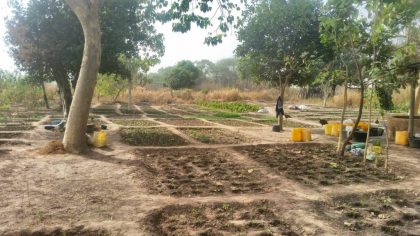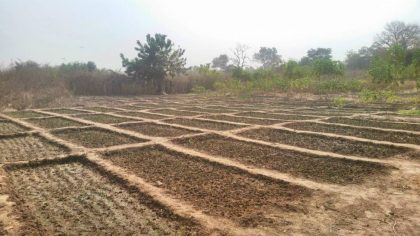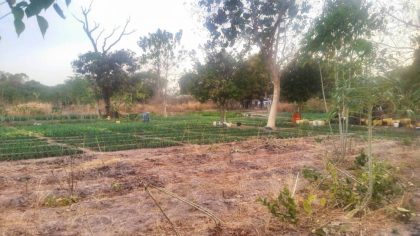This project is made possible through the partnership of WATER CHARITY and the NATIONAL PEACE CORPS ASSOCIATION. ![]()
 Location
Location
This project summary has been redacted for security reasons to omit the specific project location.
Sxxxxxxx, West Coast Region, The Gambia
Community Description
Sxxxxxxx is a medium size village with approximately 875 residents. The village is divided up into three regions known as cabilos. There are 62 compounds in the village. The village is made up of many ethnic groups. The biggest ethnic group is the Joolas, there are Fulas, Mandinkas, and Mangagos. Sxxxxxxx women’s garden is home to 50 dedicated women from the three regions (Nyassi Kunda, Bojang kunda, and Forest) of the village.
Most of the women whom work in this garden are also part of the villages Mothers club. The mothers club is responsible for providing the students at the Lower Basic Cycle (1st -9th grade) and ECD (preschool) students with all their meals during school hours.
Problem Addressed
The Sxxxxxxx women’s garden was originally established by the NGO Future in Our Hands. The NGO gave the village a skills center in 2012 and a plot of land to start growing some crops. The garden is roughly about 110m X 56m, has a well and a two-panel solar tower. The main problem that the women are facing in the garden is being able to get enough water for their garden. Through the support of the water engineering company, the women have designed their own system for getting the water they need. The solar tower has two panels and pumping machines installed on 37 meters depth well but due to the demand and quantity of the water needed to water over 400 beds of 5x1m in the garden. The pump sensor in the current system is not able to work properly because the water table fluctuates more than it was expected due to unexpected demand in the garden.
The watering system forces women to spend hours in the garden. Since more women have joined the garden and the garden has been expanded, there is more land to water and the pump isn’t delivering enough water. They don’t have much time to tend to the plants (weeding and basically keep up) because they are leaving the garden to go get water from surrounding areas. The main priority of this garden, however, is to produce enough vegetables for the students to have a more balanced diet.
Project Description
The project is to construct a borehole to provide a reliable water source for the Sxxxxxxx women’s garden.
The main objective is to help improve the production and productivity in the yields in order to improve food security, and improve the community’s economics, which will financially, in turn, empower women. It is important to note that this was identified through a vigorous community needs assessment conducted by PCVs, counterparts, and the communities. The process engages a broad set of change agents in the communities to identify local solutions to address the problem of water scarcity in the garden. In addition, the process helped to secure buy-in from the community members and mobilizes enough attention to motivate the change needed to address the problem. The process helps identify local resources to support the implementation and increased sustainability of the identified projects.
 The main project activities will included (i) drilling of 6” borehole fitted to be connected with the existing solar power (ii) connection of the system to a land network of pipes to supply water to strategic locations of the garden and (iii) training of women and girls on solutions of vegetable production and nutrition training The project capacity building will focus on technical trainings on production practices, nutrition and advocacy to achieve the expected outcomes of the project.
The main project activities will included (i) drilling of 6” borehole fitted to be connected with the existing solar power (ii) connection of the system to a land network of pipes to supply water to strategic locations of the garden and (iii) training of women and girls on solutions of vegetable production and nutrition training The project capacity building will focus on technical trainings on production practices, nutrition and advocacy to achieve the expected outcomes of the project.
The desired outcomes of the project include but are not limited to; (i) an increase in women’s financial empowerment through improvement in the production yield that in turn will increase the income from the garden, (ii) Women will better support their children, especially girls, to attain an education, (iii) The garden will provide an immediate site for the science and environmental studies lessons for the students, (iv) contribute to improving the nutritional status of the community members, especially for children and lactating mothers and pregnant women The community commitment is shown through their effort to try to raise funds to help support financially, identifying a space to be fenced, as well as involving the community in the efforts to gather some materials needed.
Project Impact
This project will benefit the entire village of 875 people
Project Administration
Laleobe Olaka, Peace Corps Volunteer
Monitoring and Maintenance
The PCV and counterpart will continually monitor the implementation of the project activities to ensure the design is being followed correctly. The PCV and counterpart will also use data provided by the school and the nearby Health Center, as well as Peace Corps Volunteer’s own collection tools, to monitor whether the project and planned interventions are meeting the short-term and long-term outcomes of this project.
 The garden that will be established will be sustained by the mothers club and the middle region of the village known as Bojang Kunda. Sxxxxxxx has three regions Nyassi Kunda, Bojang Kunda, and Forest. Each of the regions have their own bank accounts and hold annual congresses dedicated to raising funds for the projects that are established within their region. The women’s garden falls under Bojang Kunda. So, this part of the village will be responsible for any of the financial upkeep of the garden. The live fence that is started in the garden will continue to grow over the years providing more protection from animal invasion as the years go on. The garden committee that was established will be responsible for making sure the taps work well in the garden and that there is no standing water.
The garden that will be established will be sustained by the mothers club and the middle region of the village known as Bojang Kunda. Sxxxxxxx has three regions Nyassi Kunda, Bojang Kunda, and Forest. Each of the regions have their own bank accounts and hold annual congresses dedicated to raising funds for the projects that are established within their region. The women’s garden falls under Bojang Kunda. So, this part of the village will be responsible for any of the financial upkeep of the garden. The live fence that is started in the garden will continue to grow over the years providing more protection from animal invasion as the years go on. The garden committee that was established will be responsible for making sure the taps work well in the garden and that there is no standing water.
The mothers club will ensure that the students at the school are provided with a balanced diet and since new moms are always being added to the mothers club there will always be women harvesting at the garden. The income that the women make from their products will attract more people to the garden. Because more people will be drawn in by the income, they will have to be active participants in the maintenance of the garden due to the rules that were put in place at the village-wide meeting.
Let Girls Learn
This is a Let Girls Learn project! By constructing the borehole, the garden will be able to produce year-round for community members to eat and sell, which will teach self-sufficiency and self-initiative. Secondly, the garden will provide a stable source of nutrition and income for community members, especially women and children.
In addition, the availability of water will enhance the women vegetable farmers to effectively utilize their technical abilities in vegetable production for consumption and sale, to utilize their food to increase nutrition.
Furthermore, through the adequate water supply, which will in turn increase in yields the women be able to provide themselves and their children with nutritional food which will improve early childhood development and growth. Also, by improving the community’s economy, especially for women, they can better support their children in attaining an education. They will be able to ensure that their children have the supplies and materials to be successful in school. Lastly, the water adequate water supply will give better vegetative growth for a successful garden that teachers can use the location as a teaching aid in their lessons. Teachers can write interactive lesson plans that include trips to the garden for students to see the real-life application of the topics they learn in class.
Project Funding
This project has been funded through the generosity of an anonymous donor. Please make a generous donation to Water Charity so that we will be able to continue to support great projects such as this one.